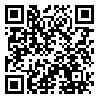BibTeX | RIS | EndNote | Medlars | ProCite | Reference Manager | RefWorks
Send citation to:
URL: http://journal.muq.ac.ir/article-1-667-en.html
2- Department of Bacteriology, Faculty of Medical Sciences, Tarbiat Modares University
Background and Objectives: Cancer is one of the leading causes of death around the world with a very high degree of mortality. Conventional therapies by cytotoxic drugs have high levels of side-effects for patient. Chitosan is a biocompatible and biodegradable compound. Thus, according to the minimum systemic toxicity for peptide and drug delivery, it is considered in applied programs. In this study, the Immunological effect of chitosan nanoparticles, was investigated on breast cancer cells in animal model.
Methods: In this experimental model, chitosan nanoparticles were synthesized. The size and electrical charge were determined using DLS apparatus and SEM. After creation of tumor model in female BALB/c mice. Injections in the test and control groups, were performed intraperitoneally. IL-4 and IFN-γ were assayed using ELISA method to investigate the immunomodulatory effects of the nanoparticles.
Results: Electric charge and size of the nanoparticles were determined and confirmed to be +11 mv and 200 nm, respectively. The nanoparticle-treated group produced large amounts of IFN-γ (213 pg/ml), while IL-4 level decreased (p<0.5).
Conclusion: These nanoparticles has the potential to shift immune responses from a Th2 to Th1 through IFN-γ production. Hence, these nanoparticles may be an appropriate and effective candidate for cancer therapy.
Received: 2016/04/10 | Accepted: 2016/04/24 | Published: 2017/04/18
| Rights and permissions | |
 |
This work is licensed under a Creative Commons Attribution-NonCommercial 4.0 International License. |







